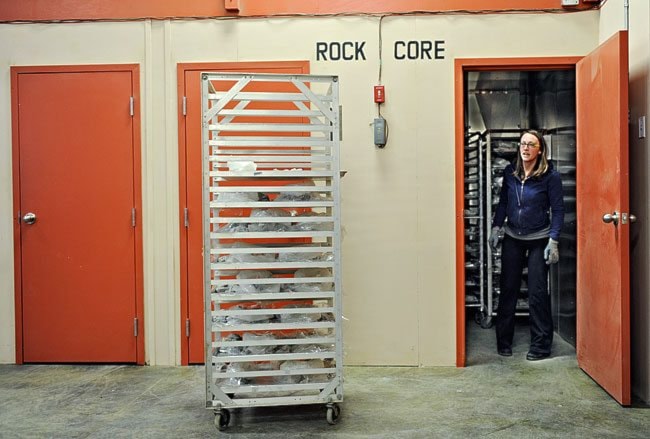Yukon’s current mining boom is largely thanks to a few bags of dirt.
Those soil samples, collected by Dawsonite Shawn Ryan, provided the telltale clues that led to the discovery of the White Gold District.
That, in turn, led to a staking rush and exploration boom in the surrounding area, and the eventual buy-out of Ryan’s discovery by mining giant Kinross.
That’s an awful lot riding on a dirt bag. And on the correct analysis of the dirt inside.
Enter ACME Laboratories, a Vancouver-based outfit with a long relationship with Ryan. They’re in the fussy, finicky business of keeping numerous bags of rock and soil in meticulous order, accurately measuring the contents and eventually producing the gold numbers that exploration outfits tout in news releases.
ACME opened its preparation laboratory in Whitehorse in February. The expansion is in large part due to Ryan, whose company, Ryanwood Explorations, has sent the lab close to 200,000 soil samples over the past eight years.
“That lab’s produced good, consistent results,” said Ryan. “They were pretty much bang-on all the time.”
ACME has several competitors in the Yukon. But they’re the biggest of the bunch, and the only one to be accredited by the International Organization for Standardization.
That means they’re serious about doing everything the exact same way, every single time.
Boring, yes. But important. Just ask Ryan.
“You have to have a consistent database, so that when you compare stuff, you see anomalies,” he said. “That’s been the downfall of most (exploration) companies.
“From one year to the next, they might just take the lowest bid. It might be a different lab with a slightly different technique. When you do that, you start mixing apples and oranges.”
And that could throw you off the trail of what Ryan calls “the Sasquatch”- every miner’s dream of striking it big.
ACME is the biggest assay lab in Canada, and ranks the fourth-largest in the world, said its president George Cartwright.
It has 19 offices in 11 countries spread across North and South America and Southeast Asia.
Globally, the company has approximately 700 workers. In Whitehorse, it employs around 20 people.
But if you’re not a miner, you’ll be forgiven if the company’s name likely makes you think about Looney Tunes, rather than the analysis of dirt and core samples.
When Dean Toye founded the company in 1971, “he thought of two words,” said Cartwright. “Accurate methods.” He combined the two and got ACME.
This was before a fictitious ACME Corporation began selling dehydrated boulders and jet-powered rollerskates to Wile E. Coyote to aid him in his pursuit of the Roadrunner, Cartwright asserts.
ACME’s job begins once an exploration company returns from the field with a pile of rock or soil. This material has already been carefully sorted into rice bags and marked before it’s dropped off at ACME’s Mount Sima premises.
Inside, four men operate noisy, mechanically driven hoppers. These machines sift soil, removing rocks and roots, and break-down core samples so that they’re small, but still statistically representative.
When their work is done, a rice bag full of rock or soil is reduced to a sample small enough to be held in what looks like a half-pound coffee bag. That bag is then stamped with a barcode and shipped to the company’s lab-rats in Vancouver.
The lab processes about 100,000 such samples during a season.
Turnaround for each sample is usually between seven to 10 days. During that period, customers can check on the status of their assays online.
Before ACME set up shop in Whitehorse, the whole bulk sample would need to be flown or trucked to Vancouver. This shipment was pricey, because of the sample’s heavy weight. It was time consuming and risky, because if the sample was lost, there was no back-up.
Now, in a worst-case scenario, a new sample can always be taken from rejected material that’s stockpiled in rows of wooden apple bins in the company’s yard.
In Vancouver, small samples containing gold are loaded into crucibles with lead, then fired into furnaces that are heated to more than 1,000 degrees Celsius - hot enough to make gold molten.
Lead helps draw out the gold. Then, when the mixture cools, the heavier lead sinks to the bottom, leaving a gold-tinged bead on the top. The bead will then undergo more tests to determine its exact chemical makeup.
But gold’s not all that matters. Ryan’s soil samples contained “pathfinder” elements, such as mercury and arsenic, which indicate that gold may be near.
The composition of Ryan’s soil samples are sniffed out with an elaborate system that involves magnetic charges, argon gas and a plasma torch that heats up to nearly 10,000 degrees Celsius. Particles are vaporized while gadgets gauge atomic shifts in mass and charge.
The test is able to identify 36 different elements - the footprints of Ryan’s Sasquatch.
Cartwright counts the Yukon to be one of the most exciting mining jurisdictions in the world right now. He expects to do healthy business here for the foreseeable future.
“The Yukon is doing really well,” said Cartwright. “I think this will continue for some time.”
ACME is privately owned by about 120 employees. Cartwright likes the setup: his shareholders understand the business, and “they’re pretty clear on why it’s important to not make mistakes.”
Contact John Thompson at
johnt@yukon-news.com.
